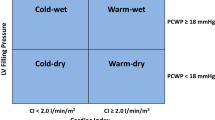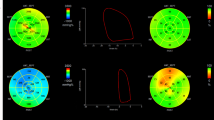Abstract
The aim of the study is to determine the utility of echocardiography in the assessment of diastolic function in children and young adults with restrictive cardiomyopathy (RCM). RCM is a rare disease with high mortality requiring frequent surveillance. Accurate, noninvasive echocardiographic measures of diastolic function may reduce the need for invasive catheterization. Single-center, prospective, observational study of pediatric and young adult RCM patients undergoing assessment of diastolic parameters by simultaneous transthoracic echocardiogram (TTE) and invasive catheterization. Twenty-one studies in 15 subjects [median (IQR) = 13.8 years (7.0–19.2), 60% female] were acquired with median left ventricular end-diastolic pressure (LVEDP) 21 (IQR 18–25) mmHg. TTE parameters of diastolic function, including pulmonary vein A wave duration (r s = 0.79) and indexed left atrial volume (r s = 0.49), demonstrated significant positive correlation, while mitral valve A (r s = −0.44), lateral e′ (r s = −0.61) and lateral a′ (r s = −0.61) velocities showed significant negative correlation with LVEDP. Lateral a′ velocity (≤0.042 m/s) and pulmonary vein A wave duration (≥156 m/s) both had sensitivity and specificity ≥80% for LVEDP ≥ 20 mmHg. In pediatric and young adult patients with RCM, lateral a′ velocity and pulmonary vein A wave duration predicted elevated LVEDP with high sensitivity and specificity; however, due to technical limitations the latter was reliably measured in 12/21 patients. These noninvasive parameters may have utility in identifying patients that require further assessment with invasive testing. These findings require validation in a multicenter prospective cohort prior to widespread clinical implementation.


Similar content being viewed by others
Abbreviations
- IQR:
-
Interquartile range
- LVEDP:
-
Left ventricular end-diastolic pressure
- RCM:
-
Restrictive cardiomyopathy
- ROC:
-
Receiver operating characteristic
- RVEDP:
-
Right ventricular end-diastolic pressure
- TTE:
-
Transthoracic echocardiogram
References
Denfield SW, Webber SA (2010) Restrictive cardiomyopathy in childhood. Heart Fail Clin 6:445–452 (viii)
Webber SA, Lipshultz SE, Sleeper LA, Lu M, Wilkinson JD, Addonizio LJ, Canter CE, Colan SD, Everitt MD, Jefferies JL, Kantor PF, Lamour JM, Margossian R, Pahl E, Rusconi PG, Towbin JA, Pediatric Cardiomyopathy Registry I (2012) Outcomes of restrictive cardiomyopathy in childhood and the influence of phenotype: a report from the pediatric cardiomyopathy registry. Circulation 126:1237–1244
Appleton CP, Hatle LK, Popp RL (1988) Relation of transmitral flow velocity patterns to left ventricular diastolic function: new insights from a combined hemodynamic and Doppler echocardiographic study. J Am Coll Cardiol 12:426–440
Nagueh SF, Middleton KJ, Kopelen HA, Zoghbi WA, Quinones MA (1997) Doppler tissue imaging: a noninvasive technique for evaluation of left ventricular relaxation and estimation of filling pressures. J Am Coll Cardiol 30:1527–1533
Nagueh SF, Lakkis NM, Middleton KJ, Spencer WH 3rd, Zoghbi WA, Quinones MA (1999) Doppler estimation of left ventricular filling pressures in patients with hypertrophic cardiomyopathy. Circulation 99:254–261
Diwan A, McCulloch M, Lawrie GM, Reardon MJ, Nagueh SF (2005) Doppler estimation of left ventricular filling pressures in patients with mitral valve disease. Circulation 111:3281–3289
Kasner M, Westermann D, Steendijk P, Gaub R, Wilkenshoff U, Weitmann K, Hoffmann W, Poller W, Schultheiss HP, Pauschinger M, Tschope C (2007) Utility of Doppler echocardiography and tissue Doppler imaging in the estimation of diastolic function in heart failure with normal ejection fraction: a comparative Doppler-conductance catheterization study. Circulation 116:637–647
Arteaga RB, Hreybe H, Patel D, Landolfo C (2008) Derivation and validation of a diagnostic model for the evaluation of left ventricular filling pressures and diastolic function using mitral annulus tissue Doppler imaging. Am Heart J 155:924–929
Nagueh SF, Smiseth OA, Appleton CP, Byrd BF 3rd, Dokainish H, Edvardsen T, Flachskampf FA, Gillebert TC, Klein AL, Lancellotti P, Marino P, Oh JK, Popescu BA, Waggoner AD (2016) Recommendations for the evaluation of left ventricular diastolic function by echocardiography: an update from the American Society of Echocardiography and the European Association of Cardiovascular Imaging. J Am Soc Echocardiogr 29:277–314
Savage A, Hlavacek A, Ringewald J, Shirali G (2010) Evaluation of the myocardial performance index and tissue doppler imaging by comparison to near-simultaneous catheter measurements in pediatric cardiac transplant patients. J Heart Lung Transplant 29:853–858
Dragulescu A, Mertens L, Friedberg MK (2013) Interpretation of left ventricular diastolic dysfunction in children with cardiomyopathy by echocardiography: problems and limitations. Circ Cardiovasc Imaging 6:254–261
Sasaki N, Garcia M, Ko HH, Sharma S, Parness IA, Srivastava S (2015) Applicability of published guidelines for assessment of left ventricular diastolic function in adults to children with restrictive cardiomyopathy: an observational study. Pediatr Cardiol 36:386–392
Seckeler MD, Hirsch R, Beekman RH 3rd, Goldstein BH (2014) Validation of cardiac output using real-time measurement of oxygen consumption during cardiac catheterization in children under 3 years of age. Congenit Heart Dis 9:307–315
Lopez L, Colan SD, Frommelt PC, Ensing GJ, Kendall K, Younoszai AK, Lai WW, Geva T (2010) Recommendations for quantification methods during the performance of a pediatric echocardiogram: a report from the Pediatric Measurements Writing Group of the American Society of Echocardiography Pediatric and Congenital Heart Disease Council. J Am Soc Echocardiogr 23:465–495 (quiz 576-467)
Weller RJ, Weintraub R, Addonizio LJ, Chrisant MR, Gersony WM, Hsu DT (2002) Outcome of idiopathic restrictive cardiomyopathy in children. Am J Cardiol 90:501–506
Border WL, Michelfelder EC, Glascock BJ, Witt SA, Spicer RL, Beekman RH 3rd, Kimball TR (2003) Color M-mode and Doppler tissue evaluation of diastolic function in children: simultaneous correlation with invasive indices. J Am Soc Echocardiogr 16:988–994
Goldberg DJ, Quartermain MD, Glatz AC, Hall EK, Davis E, Kren SA, Hanna BD, Cohen MS (2011) Doppler tissue imaging in children following cardiac transplantation: a comparison to catheter derived hemodynamics. Pediatr Transplant 15:488–494
Dipchand AI, Edwards LB, Kucheryavaya AY, Benden C, Dobbels F, Levvey BJ, Lund LH, Meiser B, Yusen RD, Stehlik J, International Society of H, Lung T (2014) The registry of the International Society for Heart and Lung Transplantation: seventeenth official pediatric heart transplantation report—2014. J Heart Lung Transplant 33:985–995
Walsh MA, Grenier MA, Jefferies JL, Towbin JA, Lorts A, Czosek RJ (2012) Conduction abnormalities in pediatric patients with restrictive cardiomyopathy. Circ Heart Fail 5:267–273
Dagdelen S, Eren N, Karabulut H, Akdemir I, Ergelen M, Saglam M, Yuce M, Alhan C, Caglar N (2001) Estimation of left ventricular end-diastolic pressure by color M-mode Doppler echocardiography and tissue Doppler imaging. J Am Soc Echocardiogr 14:951–958
Mi YP, Abdul-Khaliq H (2013) The pulsed Doppler and tissue Doppler-derived septal E/e’ ratio is significantly related to invasive measurement of ventricular end-diastolic pressure in biventricular rather than univentricular physiology in patients with congenital heart disease. Clin Res Cardiol 102:563–570
Geske JB, Sorajja P, Nishimura RA, Ommen SR (2007) Evaluation of left ventricular filling pressures by Doppler echocardiography in patients with hypertrophic cardiomyopathy: correlation with direct left atrial pressure measurement at cardiac catheterization. Circulation 116:2702–2708
Okumura K, Slorach C, Mroczek D, Dragulescu A, Mertens L, Redington AN, Friedberg MK (2014) Right ventricular diastolic performance in children with pulmonary arterial hypertension associated with congenital heart disease: correlation of echocardiographic parameters with invasive reference standards by high-fidelity micromanometer catheter. Circ Cardiovasc Imaging 7:491–501
Acknowledgements
The authors wish to acknowledge support from the Heart Institute Research Core, as well as the dedicated sonographers and cardiac catheterization laboratory personnel who made performance of this study possible.
Author information
Authors and Affiliations
Corresponding author
Ethics declarations
Conflict of interest
TD Ryan, PC Madueme, JL Jefferies, EC Michelfelder, JA Towbin, JG Woo, RD Sahay, EC King, R Brown, RA Moore, MA Grenier, BH Goldstein declares that they have no conflict of interest.
Ethical Approval
All procedures performed in studies involving human participants were in accordance with the ethical standards of the institutional and/or national research committee and with the 1964 Helsinki Declaration and its later amendments or comparable ethical standards.
Informed Consent
Informed consent was obtained from all individual participants included in the study.
Electronic supplementary material
Below is the link to the electronic supplementary material.
Supplemental Table 1
Intra-class correlation coefficient (ICC) for selected echocardiogram values. Measurement of ICC was taken in 10 studies (47%). Higher values represent stronger agreement, with 0.0–0.2 indicating very little agreement, 0.2–0.4 little agreement, 0.4–0.6 moderate agreement, 0.6–0.8 strong agreement and 0.8–1.0 very strong agreement (DOCX 11 kb)
Rights and permissions
About this article
Cite this article
Ryan, T.D., Madueme, P.C., Jefferies, J.L. et al. Utility of Echocardiography in the Assessment of Left Ventricular Diastolic Function and Restrictive Physiology in Children and Young Adults with Restrictive Cardiomyopathy: A Comparative Echocardiography-Catheterization Study. Pediatr Cardiol 38, 381–389 (2017). https://doi.org/10.1007/s00246-016-1526-0
Received:
Accepted:
Published:
Issue Date:
DOI: https://doi.org/10.1007/s00246-016-1526-0




